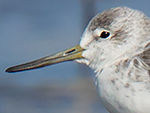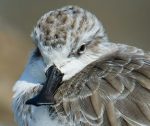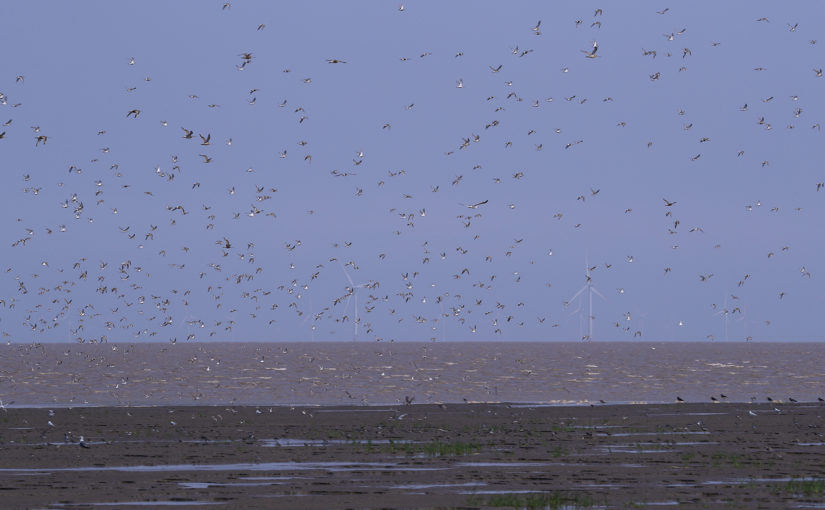by Xiaoni Xu
for shanghaibirding.com
I spent three days, 24-26 August 2020, birding Dongtai-Tiaozini and Rudong-Yangkou. For me, these two places on the Jiangsu coast north of Shanghai are like El Dorado—they are among the best-known places for birding in China, during migration season providing an extremely wide range of shorebirds. I heard about these places through other birders from China while I was in the United States, and some online searching led me to posts on shanghaibirding.com, which confirmed the excellence of this birding spot.
I was able to do only a little preparation before I set off, and although I was keen to spend all my time birding, the fact that I was traveling with my family, some of whom are seniors, did not allow me to have an extremely rigorous schedule. Unlike my morning walks around the University of Chicago, where I am a student, that start at 5:30 a.m. and last for 7 hours, or my hikes at Indiana Dunes for over 10 kilometers, my birding trips in Jiangsu were usually kept under 2 hours. Also, I am still a new birder in China, and much of the advice and experiences I share below may not be the optimal way of birding here. I thought however that providing some of my approaches to birding would be helpful for anyone who would like to visit.
Tide is a huge factor for birders on the mudflats. You generally want to set up your spotting scope when high tide is beginning to peak or when it is about to turn. Tidal information is available online. You would especially want to visit during a spring tide, that is, when the maximum tide is high. Each day high tide shifts by 1 or 2 hours, so prepare accordingly. If the water covers the entire mudflat, then the inner pond is also quite productive, since it is the place where the shorebirds have been chased to. I saw my only Ruddy Shelduck and Eurasian Spoonbill in these inner ponds.
Also, check the weather. Late August is humid and hot (highs of about 32°C/90°F), with intense sunlight that can cause sunburn. It is also very windy along the seawall.
Please be aware that vehicles are prohibited on the long road along the seawall at Dongtai-Tiaozini (south entrance: 32.759499, 120.962893). We were left with no options but to walk for miles along that road. Later I talked with some photographers who apparently had driven their cars inside. They said they had registered their cars with the local administration, but I could not find information about this arrangement anywhere on the internet. I assume that you need to know someone who knows people affiliated with this tourist area to drive inside. The parking lot has signs saying that it is closed at 5 p.m., but the fact is that you can drive out almost any time you want, as long as it is not extremely late at night (we left at 6:30 p.m.). Also, when setting up the spotting scope inside the inner fishing ponds, we were told not to enter, as the person stopping us explained that we would “scare the birds that need to be protected.” We went however to the exact same place the next day, and no one showed up.
My routine is to bird during the day, constantly referring to the Merlin app and taking pictures of large flocks with my camera and through the scope. Then in the evening I go through the pictures on my laptop to see if I missed anything. I use eBird as my main source of information and checklist-keeping database.
During my three-day trip, unfortunately, I could not find Spoon-billed Sandpiper. By the third day I had a grasp of how to pick out Spoon-billed Sandpiper, but by that time I was already in Rudong-Yangkou, where Spoon-billed Sandpiper has virtually disappeared. I thought I saw one, but it turned out to be Red-necked Stint. However, I almost got all other species present on the mudflats that were recorded at the same time of the year in the past on eBird, many in huge flocks dominated by Dunlin and Lesser Sand Plover. The photographers I mentioned took photos of birds as hobbies—they would walk down the mudflats as the tide ebbed and lie face down for hours to shoot some marvelous pictures of Spoon-billed Sandpiper. They said that finding them using a spotting scope is very easy, which is what they seem to be able to do every day—a matter of practice, perhaps. Recent censuses have resulted in around 30 Spoon-billed Sandpiper in Tiaozini and only 3 in Yangkou out of about 30,000 and 2,000 shorebirds, respectively.
For birding, Dongtai-Tiaozini is much better than Rudong-Yangkou in terms of natural environment and practicality. At Rudong-Yangkou, the mudflats have been invaded by the rapidly spreading introduced species Smooth Cordgrass Spartina alterniflora. The cordgrass is very disadvantageous to shorebirds, which have evolved to exploit open mudflats, not mudflats covered with vegetation. Dongtai-Tiaozini is also suffering, but less so.
Besides Smooth Cordgrass, at Rudong-Yangkou another destroyer of the environment is the new tourist attractions being developed right next to the last standing mudflats. I would therefore suggest not visiting Yangkou, especially if your time is short, but only focusing on Tiaozini. If however you ever want to visit, try this location: 32.598917, 121.021777. Enter from the west side—for unknown reasons, the east side was blocked off when I visited. It is one of the only mudflats that has yet to be invaded by cordgrass, and there were still thousands of shorebirds there, but still fewer than at the best places at Tiaozini.
The Magic Wood at Yangkou (32.577334, 121.004174) had Lesser Cuckoo and Eurasian Hoopoe when I visited and later in the year will attract dozens of species of passerine. The small wood at Haiyin Temple (32.560366, 121.039813), once perhaps the best coastal microforest in the entire Shanghai region, has been turned into a zoo. When I went, the zoo was not even open. It is a sad fate for a hotspot that used to be quite popular and teeming with migrating birds.
With 76 species and more than 30 lifers under my belt, I packed up, tasted some local specialties—seafood, just like those being eaten by the plovers and sandpipers—and headed home. The trip was full of the wonders of nature: the wind, the tide, the sea, and the birds. I would like to thank Craig Brelsford of shanghaibirding.com, who helped me plan out this trip, and J. Cooper and W. Lu from the University of Chicago, for providing information related to bird ID and Jiangsu. It was a great birding experience, and I will gladly visit again.
Here are the checklists from the three-day trip:
Day 1: https://ebird.org/checklist/S72766258
Day 2: https://ebird.org/checklist/S72799293
Day 3: https://ebird.org/checklist/S72827952
Please keep in mind that there could be misidentified species, although I tried my best not to include the ones I saw through the scope but was unable to identify.
Complete list of birds seen on the trip:
Ruddy Shelduck Tadorna ferruginea
Eastern Spot-billed Duck Anas zonorhyncha
Ring-necked Pheasant Phasianus colchicus
Little Grebe Tachybaptus ruficollis
Rock Pigeon Columba livia
Spotted Dove Streptopelia chinensis
Lesser Cuckoo Cuculus poliocephalus
Black-winged Stilt Himantopus himantopus
Pied Avocet Recurvirostra avosetta
Eurasian Oystercatcher Haematopus ostralegus
Black-bellied Plover Pluvialis squatarola
Pacific Golden Plover P. fulva
Grey-headed Lapwing Vanellus cinereus
Lesser Sand Plover Charadrius mongolus
Greater Sand Plover C. leschenaultii
Kentish Plover C. alexandrinus
Little Ringed Plover C. dubius
Whimbrel Numenius phaeopus
Far Eastern Curlew N. madagascariensis
Eurasian Curlew N. arquata
Bar-tailed Godwit Limosa lapponica
Black-tailed Godwit L. limosa
Ruddy Turnstone Arenaria interpres
Red Knot Calidris canutus
Broad-billed Sandpiper C. falcinellus
Sharp-tailed Sandpiper C. acuminata
Curlew Sandpiper C. ferruginea
Long-toed Stint C. subminuta
Red-necked Stint C. ruficollis
Sanderling C. alba
Dunlin C. alpina
Asian Dowitcher Limnodromus semipalmatus
Terek Sandpiper Xenus cinereus
Common Sandpiper Actitis hypoleucos
Green Sandpiper T. ochropus
Spotted Redshank T. erythropus
Common Greenshank T. nebularia
Nordmann’s Greenshank T. guttifer
Marsh Sandpiper T. stagnatilis
Common Redshank T. totanus
Saunders’s Gull Saundersilarus saundersi
Black-headed Gull Chroicocephalus ridibundus
Black-tailed Gull Larus crassirostris
Lesser Black-backed Gull L. fuscus
Little Tern Sternula albifrons
Gull-billed Tern Gelochelidon nilotica
Caspian Tern Hydroprogne caspia
White-winged Tern Chlidonias leucopterus
Whiskered Tern C. hybrida
Common Tern Sterna hirundo
Grey Heron Ardea cinerea
Great Egret A. alba
Little Egret Egretta garzetta
Chinese Pond Heron Ardeola bacchus
Black-crowned Night Heron Nycticorax nycticorax
Eurasian Spoonbill Platalea leucorodia
Black-faced Spoonbill P. minor
Eurasian Hoopoe Upupa epops
Black Drongo Dicrurus macrocercus
Ashy Drongo D. leucophaeus
Brown Shrike Lanius cristatus
Long-tailed Shrike L. schach
Azure-winged Magpie Cyanopica cyanus
Oriental Magpie Pica serica
Barn Swallow Hirundo rustica
Red-rumped Swallow Cecropis daurica
Light-vented Bulbul Pycnonotus sinensis
Red-billed Starling Spodiopsar sericeus
White-cheeked Starling S. cineraceus
Crested Myna Acridotheres cristatellus
Chinese Blackbird Turdus mandarinus
Dark-sided Flycatcher Muscicapa sibirica
Oriental Magpie-Robin Copsychus saularis
Eurasian Tree Sparrow Passer montanus
White Wagtail Motacilla alba
Chinese Grosbeak Eophona migratoria
FURTHER READING
shanghaibirding.com is a clearinghouse of information about birding coastal Jiangsu. See also
— Birding the Jiangsu Coast in May
— Will Spoon-billed Sandpiper Hold On at Beleaguered Jiangsu Sites Such As Rudong-Yangkou?
See also our Destination pages for Dongtai-Tiaozini and Rudong-Yangkou.
Featured image: Despite the manic development of the Jiangsu coast, pockets of good habitat remain, notably in Dongtai County. Here, huge flocks containing hundreds of birds of various species still assemble. (Xiaoni Xu)



